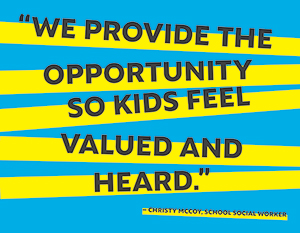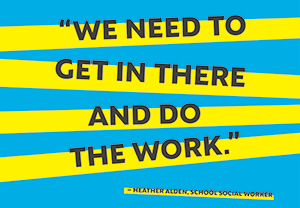When a young girl saw a game of tag for the first time, she was afraid.
She did not understand that touching and running away was part of playing a game, said Heather Alden, school social worker at EXPO Elementary School. The youngster’s family had immigrated to St. Paul, Minn., from a refugee camp after escaping a country embroiled in civil war.
“A lot of East Africans come from places with a lot of trauma,” Alden said. “You have to teach them how to play and that it’s safe. That’s something you don’t think about, but it’s important because they don’t necessarily know how to play.”
As schools across the country cope with violence and its prevention, school social workers are instrumental, helping students with recovery or fears it could happen to them. They are at the forefront of safety planning and drills. And they are working to prevent school violence before it happens, because, Alden said, the way to prevent school violence is to teach kids the appropriate way to interact with each other in elementary school.
“
More than 187,000 students attending at least 193 primary or secondary schools have experienced a shooting on campus during school hours.
Rising Tide
“Beginning with Columbine in 1999, more than 187,000 students attending at least 193 primary or secondary schools have experienced a shooting on campus during school hours,” according to a year-long Washington Post analysis. “This means that the number of children who have been shaken by gunfire in the places they go to learn exceeds the population of Eugene, Ore., or Fort Lauderdale, Fla.,” the Washington Post states in its story “Scarred by School Shootings.” The paper updates its statistics periodically, and those figures were updated March 25.
The National Center for Education Statistics’ July 2017 report “Crime, Violence, Discipline, and Safety in U.S. Public Schools,” based on data gathered in the 2015 to 2016 school year, found the rate of violent incidents per 1,000 students was 27 in middle schools, 16 in high schools and 15 in primary schools.
“About 39 percent of schools reported at least one student threat of physical attack without a weapon, compared with 9 percent of schools that reported such a threat with a weapon,” it states.vSeventy-four percent of suburban schools and 73 percent in cities reported they had formal programs to prevent or reduce violence “that included social emotional learning training for students,” while town schools reported a 62 percent rate and rural areas reported 51 percent.
Ninety-five percent of schools reported having student lockdown drills, 92 percent had evacuation procedures and 76 percent reported having shelter-in-place procedures
Other data cover threats, weapon possession, bullying and cyberbullying.
Prevention Works

At least 50 percent of all children experience some form of violence during their school careers, and some say that number is even higher, said Richard F. Catalano Jr.
“The rates aren’t necessarily pervasive, but think about the children—the victims or the perpetrators,” he said.
Catalano, PhD, is the Bartley Dobb Professor for the Study and Prevention of Violence at the Social Development Research Group at the University of Washington School of Social Work in Seattle. He is co-founder of the research group and is a professor of social work and adjunct professor of both sociology and education.
The propensity toward violence starts at about age 10 or 11, peaks around age 17 and begins falling in the 20s. The frontal cortexes are not fully developed until about age 25, he said.
“As they gain more cognitive skill, the rates go down,” Catalano said. “On the other hand, there are certain risk
and protective factors.”
What children experience in their communities, families and peer groups influences their behavior, he said.
“If there are good family practices, it’s less likely they will be involved in violence,” Catalano said. “If kids feel protected, if their family, school and community have strong attachments and recognize them for good behavior, they’re less likely as well. But there’s no silver bullet.”
There are a large number of proven prevention programs that work, he said, pointing to the Chicago Child-Parent Centers, which provide socio-emotional preparation for youngsters ages 3 to 5 to prepare them for school.
Blueprints Programs focus on prevention, and their 38 programs have shown strong evidence of success, Catalano said.
One size does not fit all, but Blueprints is a good source for teachers and social workers to find a good program for their setting, he said.
“Building kids’ social and emotional capacity can prevent violence in the future,” Catalano said. “Studies show many years in the future—15 years later—they show less violence.”
“To cut to the chase, we have interventions that can be done in preschool and primary school and middle school and high school. What we don’t have is the political will to put these things in place that can prevent things like the school shootings we’ve been having over a period of time.
Why aren’t we doing it? That’s the question.”
“
Actions like bullying, threats and fights are all red flags, and they need to be addressed before they elevate and students become a threat to themselves or others.
Libby Nealis, MSSW
School Social Work
Libby Nealis, MSSW, and director of policy and advocacy at the School Social Work Association of America, said some states, and schools within some jurisdictions, do not employ social workers. Many have counselors, who largely hold academic roles, like talking to students about grades and going to college.
“Work in schools is very scattered for social workers,” she said. “The more funding a school has, the more services it can provide.”
Actions like bullying, threats and fights are all red flags, and they need to be addressed before they elevate and students become a threat to themselves or others. And social workers do all those things well, Nealis said.
“What’s needed is an elevated discussion, lots of funding and training,” Nealis said. “Teachers need it too. They don’t understand the effects on a trauma-affected brain.”School funding is up to the states and local districts.
There is no direct funding from the federal government, she said, although the new education bill is “huge.” It’s a
$1.1 billion program, and 20 percent of it is targeted for school mental health and safety.
“In response to Parkland, many schools have put a lot of money into equipment and school resource officers,” Nealis said. “A lot of priorities need to be set, and social workers need to be vocal. They can try partnering with the justice folks, making sure they’re properly trained. There are way more of them than social workers or mental health people.”
Agape High School
Christy McCoy, MSW, LICSW, is board secretary and legislative chair for SSWAA, and secretary and legislative chair for the Minnesota School Social Work Association, where she is also past president.
“It’s a crucial time right now, a time for a lot of questions,” said McCoy, the school social worker at Agape High School in St. Paul. “Sadly, it’s taken tragedy for us to take time to have this dialogue. At all kinds of schools, all school employees prepare for potential emergencies and hope we do not have to enact some plans.”
School social workers collaborate with counselors, nurses, school resource officers, and everyone in the school office so any needed response would be immediate. Social workers would provide follow-up services to members of the school community affected by trauma, she said.
Her school is for girls who have babies or are pregnant, and last year, one of their graduates was murdered by the father of her child, McCoy said.
“It was one year after she graduated, so she was no longer a student, but we had students who knew her, teachers and staff who knew her,” she said.
McCoy worked with the administrator and school counselor to come up with a strategic plan and decide what kind of support would be provided to students and staff.
“We provided individual support for students—trauma informed care, and group therapy,” she said. “We’re in a pivotal position to help with crises, but what we do afterwards is help with pain and fears.”
She also does “a lot” of preventive work.
On regular school days, McCoy does group therapy to help students learn coping skills. She also works with families to deal with whatever issues they may be going through
“If we see mental illness or bullying happen, we know how to engage and how to prevent it,” she said. “We also provide a lot of emotional learning competencies.”

“No. 1 is, we’ve established a community and have interventions in place. We provide the opportunity so kids feel valued and heard.”
As a team, they have implemented restorative practices in case of a conflict. If something happens, students, family members and teachers can all be brought in.
“It’s been really effective,” McCoy said. “School social workers have the expertise to engage the system with effective practices. For us, being that bridge and making sure things get done, it’s ongoing. It’s not just one shot and done.”
No one is profiled, but they pay attention to warning signs, like things said in student writings, so they can be aware of and deal with anything that might become a problem, she said. “One of our roles is to empower the school staff to be aware and engage with students too,” McCoy said. “It could be the custodian—any staff member—because that’s what creates a safe learning community: relationships.”
Strategic supervision is utilized. In the lunchroom, for example, teachers and staff should walk around the cafeteria and engage with students so they know what’s going on. In the hallway, don’t just stand there. Engage with students, have conversations, she said.
McCoy said if something happens and students are asked why didn’t they say something, you do not want them to say “I felt invisible. I thought I didn’t matter.”
To address some issues, they can provide mental health service delivery at the school and bring in the family.
“It’s important to establish community partnership,” McCoy said. “You have to understand the community to work with it. You have to know not all families have the same cultural values, and they might not be aligned with what they see as their child’s mental health. We work to make sure we can be that bridge so we’re able to get those kids back into class and be academically successful.”
She believes it is imperative to partner with and collectively build support around students, families, the school and communities.
“That’s where I think we can be most effective in preventing tragedy from happening,” McCoy said. “It takes a lot of training, trust and evaluation, and at the end of the year, more evaluation. What can we do better next year? I think that’s all important.”
Her entire career has been in alternative high school settings
“Some of those families, by the time they get to those schools, are kind of disenfranchised from school systems,” McCoy said. “My job is to re-engage them and build some trust.”

She developed Culture Day, where a student brings in family members, and other students hear them talk about who they are and where they come from.
“The girls get to know who they’re sitting next to every day,” McCoy said. “I like to take it to a deeper level and have students share their traditions, values and beliefs. It’s a journey.”
“Another thing: it’s a learning experience. They’re doing presentations, using speaking skills. They’re doing Power Point presentations. For girls who have experienced trauma, they’re using those to tell a story.”
One family was from Burma. They fled after seeing family members killed and dismembered in front of them, leaving their homes and hiding in the jungle with nothing but the clothes on their backs, she said.
“When they have the opportunity to share their stories, it’s really powerful, not only for the girls, but for our own community,” McCoy said.
When school shootings happen elsewhere, some are afraid.
“It’s a normal trauma response that can impact attendance,” McCoy said. “That’s my role. The first thing is to reassure them that when they come to school they’re safe.”
The school has a controlled entrance, visitors must show IDs, and lockdown drills are practiced to make sure students are safe if something does happen.
After Parkland, just a few students participated in the local march.
“What was really neat is most of the students decided they wanted to go a different route,” McCoy said. “Several decided to write letters to (U.S.) Sen. (Amy) Klobuchar about gun violence prevention and what makes a safe school.”
Then she selected two students and had them present a talk on what makes this school feel safe for you at the annual Day on the Hill.
“They actually got to meet the mayor of St. Paul,” McCoy said. “It was wonderful for them to have that opportunity.”
She believes school social work provides the opportunity to embrace a leadership role, and always has emphasized the importance of advocacy, “not only for our school, but for social justice and equitable resources for all.”
McCoy said that means social workers “have to take it outside, and you have to talk about it. Think about DACA. These people have escaped. They’ve worked hard for our society. They’ve engaged at the community level, the state level and nationally. Our job as social workers is to advocate for all. I think that’s just as important and a part of our work.”
“I feel very grateful to be able to do this work. I feel it’s not a job, it’s a calling.”
McCoy received the Career Achievement Award this spring from the MSSWA.
Expo Elementary

In grade schools, “violence has different degrees in impact, so we try to keep it small by teaching kids how to work through social interaction,” said Alden, MSW, LICSW, and president of the Midwest School Social Work Council.
Children are taught how to play, celebrate differences, learn about each other and honor each other, and they are allowed the space for that to happen, she said.
“We use the RTI model,” Alden said. “We run friendship groups and do social modeling, like on how to work through a problem.”
The types of violence they see can include bullying—like triangulation, when two friends exclude a third friend.
“We typically don’t see weapons in elementary, but we will see some fistfights from time to time,” Alden said. “Basically, everything in elementary is really small.”
“We spend a lot of time building community in the classroom, creating norms so they know how to behave and do better.”
Safety measures include lockdown drills and preparatory training for students.
“It’s pretty scary for them, but we do it in a way so they know they’re safe and we have a plan,” Alden said.
“Adults model behavior so they know they’re OK and safe.”
They do lots of integrating with parents so they will be mindful of what kids are exposed to at home, she said.
“For example, after Parkland happened, CNN looped it, replaying it over and over again,” Alden said. “Kids thought it was happening again and again because they did not understand. We explained that to parents and talked about information kids were exposed to.”
The kind of triage they most likely do is if they hear a child say “Oh, I just want to die” or “I’m gonna kill this person,” she said.
“We spend time with the kids and talk to them about how to express their views appropriately,” Alden said. “We tell them: A: they have to figure out what the appropriate words are to explain how they’re feeling, and B: they have to understand when they make comments like that, they have implications.”
“Lots of times kids say something they don’t mean. We have to figure out does the child intend to do harm and help them understand that how they say things matters. You have to really know the culture of kids and their families and communities.”
The EXPO population has a mix of families, from some who have higher opportunities to those who are homeless, and St. Paul is a city with many cultures and many spoken languages, she said.
“It’s a beautiful mix of kids and families from all over the world,” Alden said. “Many have challenging histories and trauma.”
There are 750 children and she is the only social worker, but “we have a counselor,” Alden said. “I take the more clinical cases and she works a lot with special-needs kids. We divide it up.”
Alden also plays a role in the community, working with families and doing home visits. But her “favorite thing to do” is a project she developed called Project Connection, a monthly school-based mentoring program with 25 at-risk kids, their siblings and families and school staff including the principal, nurse, custodian and teachers.
The kids feel like “it’s my place,” families see it’s a good place to be, and it’s “awesome” for the staff, she said.
In January, they all went sledding. Another time, they went to a Twins game. They built kites and flew them in April, and in May, they had a barbecue.
“It’s to create space for a lot of students who have had a lot of trauma,” Alden said. “It’s the most amazing program, and it’s working. We’ve done it for eight or nine years, and now more parents show up for programs at school. It’s so awesome, and it really makes a huge difference.”
She believes the most important things about preventing school violence are: building relationships with kids and families; being available, and continuing relationships, because all kids need to be seen; and remembering the ones highest at risk and feeling disenfranchised are the ones who aren’t seen.
Near the top of its web page titled “Role of School Social Worker,” the SSWAA has a quote from Alden, their 2012 National School Social Worker of the Year.
“We need to get in there and do the work. We may do our work in a classroom, at a table, under a table, outside of a home on the front porch or through a screened door. We may do our work with puppets and clay or graffiti and spoken word, before school or during lunch...nonetheless, we do the work.”